| Listing 1 - 10 of 14 | << page >> |
Sort by
|
Book
Year: 1963 Publisher: Taibei : Shang Wu Yin Shu Guan,
Abstract | Keywords | Export | Availability | Bookmark
 Loading...
Loading...Choose an application
- Reference Manager
- EndNote
- RefWorks (Direct export to RefWorks)
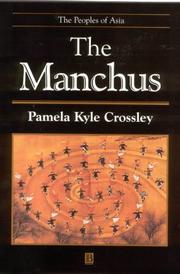
ISBN: 0631235914 Year: 2002 Publisher: Oxford : Blackwell,
Abstract | Keywords | Export | Availability | Bookmark
 Loading...
Loading...Choose an application
- Reference Manager
- EndNote
- RefWorks (Direct export to RefWorks)
Book
ISBN: 9780674036123 0674036123 Year: 2009 Volume: *2 Publisher: Cambridge Belknap press of Harvard university press
Abstract | Keywords | Export | Availability | Bookmark
 Loading...
Loading...Choose an application
- Reference Manager
- EndNote
- RefWorks (Direct export to RefWorks)
China --- Chine --- History --- Histoire --- S04/0680 --- China: History--Qing: general: 1644 - 1912 --- China - History - Qing dynasty, 1644-1912
Book
ISSN: 12516007 ISBN: 2877302385 9782877302388 Year: 1995 Volume: 35 Publisher: Arles Picquier
Abstract | Keywords | Export | Availability | Bookmark
 Loading...
Loading...Choose an application
- Reference Manager
- EndNote
- RefWorks (Direct export to RefWorks)
Yu Chunhe est entré dans la Cité Interdite en 1898, à l'âge de 17 ans, pour devenir eunuque près de l'impératrice Xiaoding. Ses mémoires riches en intrigues et portraits acerbes des familiers de la Cour sont le témoignage d'une époque, de sa décadence et de sa corruption
Eunuchs --- S11/0741 --- Men --- China: Social sciences--Eunuch --- Forbidden City (Beijing, China) --- China --- History --- Eunuchs - China - Anecdotes --- China - History - Qing dynasty, 1644-1912 - Anecdotes
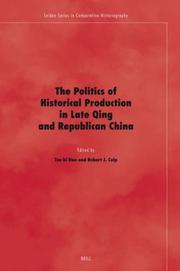
ISBN: 9789004160231 900416023X 9786611921668 1281921661 9047421442 Year: 2007 Volume: 2 Publisher: Leiden Brill
Abstract | Keywords | Export | Availability | Bookmark
 Loading...
Loading...Choose an application
- Reference Manager
- EndNote
- RefWorks (Direct export to RefWorks)
This book examines forms of Chinese historical production happening outside the mainstream of academic history, through such new measures as the publication of textbooks, the writing of local history, the preservation of archival materials, and government attempts to establish orthodox historical accounts. The book does so in order to broaden the scope of modern Chinese historiography, when it focuses primarily on a small group of writers such as Liang Qichao, Gu Jiegang, and Fu Sinian. Directly linking historical writings to the formation of the nation, the justification of elite authority, and the cultivation of active citizenry, this book shows that historiography is essential to understanding the uniqueness of Chinese modernity. Also available in paperback .
China --- Historiography. --- History --- China -- Historiography. --- China -- History -- Qing dynasty, 1644-1912. --- China -- History -- Republic, 1912-1949. --- East Asia --- Regions & Countries - Asia & the Middle East --- History & Archaeology --- S04/0200 --- S04/0300 --- S14/0400 --- China: History--Historiography and theory of history --- China: History--Outlines, study and teaching books, reference books, manuals --- China: Education--Modern education: before 1949 (incl. Modern intellectual trends)
Book
ISBN: 9782912107671 2912107679 Year: 2012 Publisher: Paris : Raisons d'agir,
Abstract | Keywords | Export | Availability | Bookmark
 Loading...
Loading...Choose an application
- Reference Manager
- EndNote
- RefWorks (Direct export to RefWorks)
Aux XVIIe et XVIIIe siècles, trois grandes puissances se déployaient en Asie. Les empires Qing en Chine, moghol en Inde et russe plus au Nord étaient capables de projeter des troupes nombreuses sur des milliers de kilomètres. Mais où ces empires puisaient-ils les ressources nécessaires aux campagnes et à la stabilité des conquêtes ? À partir de cette question, Alessandro Stanziani revisite l'histoire de la construction impériale, de ses fondements sociaux et économiques, de ses dynamiques, en portant un regard large sur le fonctionnement des organisations militaires de ces États. Ce n'est pas dans le pouvoir du nombre (la population chinoise ou indienne), ni dans l'étendue du territoire et encore moins dans leur caractère "despotique" qu'il faut chercher la force des empires russe, chinois et moghol, leurs différentes évolutions ainsi que le résultat de leur confrontation avec l'Occident. Ainsi, certains éléments sont communs aux trois empires : leur capacité à intégrer des ethnies et des religions différentes, leur aptitude à mobiliser des ressources agricoles et militaires, l?importance du commerce, des organisations bureaucratiques complexes. Les différences sont tout aussi remarquables : les Chinois développent davantage le marché afin d'approvisionner l'armée ; les Russes ont recours aux soldats-colons et procèdent à une centralisation importante de leur administration, tandis que les Moghols misent sur la décentralisation de la fiscalité et de l'armée.
China --- Russia --- Mogul Empire --- Chine --- Russie --- Empire moghol --- History --- Histoire --- Imperialism --- Asia --- Politique et gouvernement --- Histoire. --- Eurasie --- Politics and government --- History. --- Imperialism - History --- Asia - History --- Russia - History - 1613-1917 --- Russia - History - 1533-1613 --- China - History - Qing dynasty, 1644-1912 --- China - History - Ming dynasty, 1368-1644 --- Mughal Empire
Book
ISBN: 9789993794769 9993794767 Year: 2013 Volume: 7 Publisher: Macau Macau Ricci institute
Abstract | Keywords | Export | Availability | Bookmark
 Loading...
Loading...Choose an application
- Reference Manager
- EndNote
- RefWorks (Direct export to RefWorks)
Chinese rites --- Missions --- Kangxi, --- Jesuits --- China --- History --- Civilization --- S13B/0410 --- S02/0310 --- China: Christianity--Jesuits (incl. Rites Controversy) --- China: General works--Intercultural dialogue --- Missions - China --- Chine --- Jésuites --- Kangxi, - Emperor of China, - 1654-1722 --- China - History - Qing dynasty, 1644-1912 --- China - Civilization - Congresses
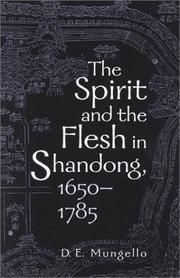
ISBN: 0742511642 0742511634 9780742511644 Year: 2001 Publisher: Totowa Rowman & Littlefield
Abstract | Keywords | Export | Availability | Bookmark
 Loading...
Loading...Choose an application
- Reference Manager
- EndNote
- RefWorks (Direct export to RefWorks)
Shandong Sheng (China) --- China --- Church history --- History --- S13B/0200 --- S13B/0420 --- 27 <51> --- 266 <51> --- China: Christianity--General works --- China: Christianity--O.F.M., Franciscans --- Kerkgeschiedenis--China --- Missies. Evangelisatie. Zending--China --- Shantung, China --- Shandong (China : Province) --- Shan-tung sheng (China) --- Shantung Province (China) --- Santō-shō (China) --- Schantung (China) --- Shan Dong Province (China) --- Shan dong sheng (China) --- Shan-tung (China : Province) --- Shan dong (China : Province) --- Church history. --- 山东省 (China) --- Shandong Sheng (China) - Church history --- China - History - Qing dynasty, 1644-1912
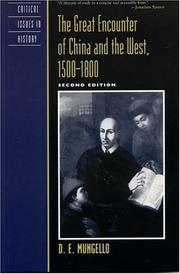
ISBN: 0742538141 074253815X 9780742538153 Year: 2005 Publisher: Lanham (Md.) : Rowman and Littlefield,
Abstract | Keywords | Export | Availability | Bookmark
 Loading...
Loading...Choose an application
- Reference Manager
- EndNote
- RefWorks (Direct export to RefWorks)
East and West --- Orient et Occident --- China --- Europe --- Chine --- Eurpe --- Civilization --- Western influences. --- Chinese influences. --- History --- Civilisation --- Influence occidentale --- Influence chinoise --- Histoire --- 951.07 --- S02/0300 --- S02/0310 --- S17/1800 --- S01/0500 --- S13B/0410 --- Geschiedenis van China: Mantsjoe-keizers ; Qing-dynastie (1644-1799) --- China: General works--Chinese culture and the West and vice-versa --- China: General works--Intercultural dialogue --- China: Art and archaeology--Influence on Foreign art (incl. Chinoiserie) --- China: Bibliography and reference--Sinology, sinological institutes, proceedings of conferences --- China: Christianity--Jesuits (incl. Rites Controversy) --- 951.07 Geschiedenis van China: Mantsjoe-keizers ; Qing-dynastie (1644-1799) --- East and West. --- Civilization, Western --- Civilization, Oriental --- Occident and Orient --- Orient and Occident --- West and East --- Eastern question --- Asian influences --- Oriental influences --- Western influences --- Occidental influences --- China - Civilization - Western influences. --- Europe - Civilization - Chinese influences. --- China - History - Ming dynasty, 1368-1644. --- China - History - Qing dynasty, 1644-1912.
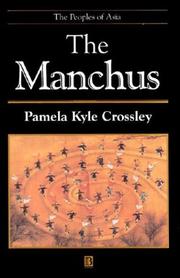
ISBN: 1557865604 Year: 1997 Volume: *1 Publisher: Cambridge (Mass.): Blackwell
Abstract | Keywords | Export | Availability | Bookmark
 Loading...
Loading...Choose an application
- Reference Manager
- EndNote
- RefWorks (Direct export to RefWorks)
S22/0500 --- S22/0200 --- Manchus --- -Manchu (Manchurian people) --- Ethnology --- Tatars --- Tungusic peoples --- North-eastern provinces (Manchuria)--History: general and before 1931 --- North-eastern provinces (Manchuria)--General works --- History --- China --- -China -- History -- Qing dynasty, 1644-1912. --- Manchus -- History. --- History. --- China -- History -- Qing dynasty, 1644-1912. --- -North-eastern provinces (Manchuria)--History: general and before 1931 --- -S22/0500 --- Cina --- Kinë --- Cathay --- Chinese National Government --- Chung-kuo kuo min cheng fu --- Republic of China (1912-1949) --- Kuo min cheng fu (China : 1912-1949) --- Chung-hua min kuo (1912-1949) --- Kina (China) --- National Government (1912-1949) --- China (Republic : 1912-1949) --- People's Republic of China --- Chinese People's Republic --- Chung-hua jen min kung ho kuo --- Central People's Government of Communist China --- Chung yang jen min cheng fu --- Chung-hua chung yang jen min kung ho kuo --- Central Government of the People's Republic of China --- Zhonghua Renmin Gongheguo --- Zhong hua ren min gong he guo --- Kitaĭskai︠a︡ Narodnai︠a︡ Respublika --- Činská lidová republika --- RRT --- Republik Rakjat Tiongkok --- KNR --- Kytaĭsʹka Narodna Respublika --- Jumhūriyat al-Ṣīn al-Shaʻbīyah --- RRC --- Kitaĭ --- Kínai Népköztársaság --- Chūka Jinmin Kyōwakoku --- Erets Sin --- Sin --- Sāthāranarat Prachāchon Čhīn --- P.R. China --- PR China --- Chung-kuo --- Zhongguo --- Zhonghuaminguo (1912-1949) --- Zhong guo --- Chine --- République Populaire de Chine --- República Popular China --- Catay --- VR China --- VRChina --- 中國 --- 中国 --- 中华人民共和国 --- Jhongguó --- Bu̇gu̇de Nayiramdaxu Dundadu Arad Ulus --- Bu̇gu̇de Nayiramdaqu Dumdadu Arad Ulus --- Bu̇gd Naĭramdakh Dundad Ard Uls --- Khi︠a︡tad --- Kitad --- Dumdadu Ulus --- Dumdad Uls --- Думдад Улс --- Kitajska --- Qing dynasty, 1644-1912 --- Manchus - History. --- China - History - Ch°ing dynasty, 1644-1912.
| Listing 1 - 10 of 14 | << page >> |
Sort by
|

 Search
Search Feedback
Feedback About UniCat
About UniCat  Help
Help News
News